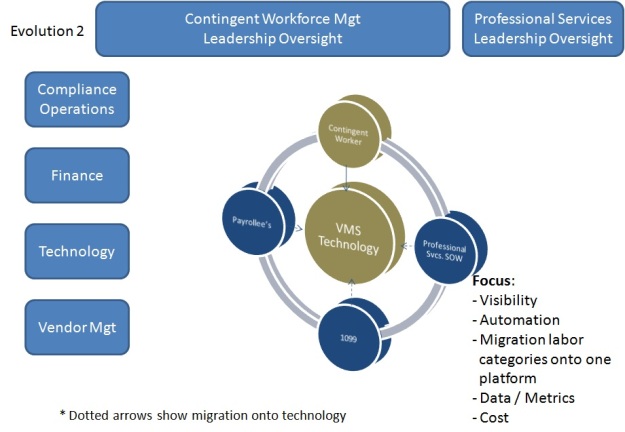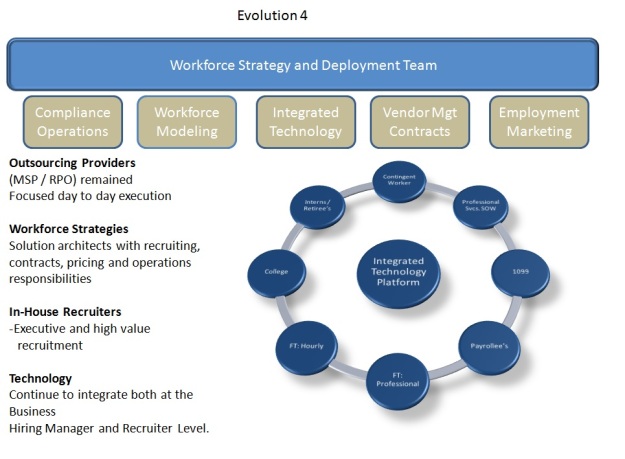Having made the transition from in-house recruitment to recruitment process outsourcing than managed services programs, you begin to see an evolution with great similarities and pains. The trends that I see are the movement towards identification, automation, measurement and operational excellence when managing all aspects of labor. This evolution is much more mature on the full-time hiring front than the contingent and professional services space. However the contingent workforce management industry is leveraging the best practices from its counterpart and their ramp towards automation and visibility is moving much more quickly.
As we begin to gain control and insight into all of the labor categories, this begs the question whether an in-house recruiting organization will look the same 10 years from now. I say it doesn’t. My prediction is Recruiting organizations will become WORKFORCE STRATEGY AND DEPLOYMENT functions. Managed services providers and recruitment process outsourcers, will focus on the flawless execution within the labor category they have been designated. Better yet, both will be focused on getting butts in seats, operations management and data management. The In-house WORKFORCE STRATEGY AND DEPLOYMENT function will work with the business to determine the best labor type needed to get the job done. Additionally there will be specialty sub functions that will focus on attraction, compliance, marketing, integrated technology solutions and vendor management within all the associated practices and processes. So where are we now? Let me show you.
In-House Recruitment Function: Full-Time Only
This is a high level view of an in-house recruitment organization, minus the nuances that a specific industry may bring to the organization. However the key thing to note is, all processes are now leveraged through an ATS system, the focus is now on process optimization, scalability, vendor management, improving marketing, sourcing and the candidate experience. Finally, the overall management of this function is moving towards metrics, the cleansing of data and trend analytics.
Contingent Workforce Management Model
At the same time, many companies are now exploring technology for contingent workforce management and the first labor category to get automated is the contingent worker provided by staffing firms. Over the next couple of years, the movement towards automation and visibility of all labor categories outside of full-time will migrate to the VMS. The VMS technology companies will continue to optimize as these functions mature and data becomes readily available. The program leaders are focused on compliance, rate controls, billing management, process management and adherence to policies.
Evolution 3
As the two groups move towards their common platform the challenge will be how they migrate this information from two solutions into meaningful business intelligence software so that it can be used. The other challenge is the maturity around the cleanliness of the data due to economic and operational limitations. As these problems get solved, new skill sets will be birthed and the role of workforce modeling and planning will move from infancy to a juvenile state.
As insights are captured and trends over time are recognized, this will challenge all stakeholders involved.
– Managers will need to shift their thinking about how to get work done – outside of full time hiring.
– HR / Procurement will need to evolve to understanding the entire labor pool and options.
– Technology firms will be challenged to deliver an integrated solution both at the system level and at the portal layer that is easy for everyone to use.
– Organizationally leaders will need to address “How does this shift the need for people, skills and the methods by which we bring labor into the organization?”
The reality is, we do much of this already in a very disparate way and this will be an evolving challenge for everyone as we learn more about whom we are and how we leverage people to get work done inside our organizations.
Evolution 4
This is the age of the Workforce Strategist. These roles are business roles that focus on labor based solutions. Outsourcers will be leveraged to optimize the delivery of their specific labor category and workforce modeling groups will drive pricing, compliance, trends and program level decision making.
While this is just a prediction and it may never fully be realized, it begs the question around IS NOW THE TIME TO CHANGE THE WAY WE LOOK AT THE ACQUISITION AND MANAGEMENT OF people driven solutions to get work done?
tfriend@brightfieldstrategies.com – Snr. Consultant



